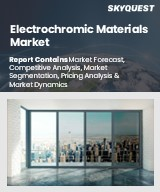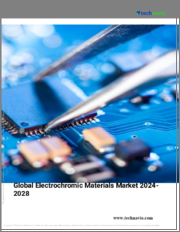
|
시장보고서
상품코드
1796115
일렉트로크로믹 재료 시장 규모, 점유율, 성장 분석 : 제품별, 용도별, 최종사용자별, 지역별 - 산업 예측(2025-2032년)Electrochromic Materials Market Size, Share, and Growth Analysis, By Product (Inorganic Electrochromic Materials, Organic Electrochromic Materials), By Application (Smart Windows, Displays), By End User, By Region - Industry Forecast 2025-2032 |
||||||
세계의 일렉트로크로믹 재료 시장 규모는 2023년에 15억 달러로 평가되며, 2024년 16억 2,000만 달러에서 2032년에는 29억 2,000만 달러로 성장하며, 예측 기간(2025-2032년)의 CAGR은 7.7%로 성장할 전망입니다.
세계 일렉트로크로믹 소재 시장은 정부 규제, 기술 혁신, 에너지 효율에 대한 중요성 증가로 인해 크게 성장하고 있습니다. 도시 계획가와 정부가 스마트 인프라 프로젝트를 우선순위로 삼고 있는 가운데, 일렉트로크로믹 기술의 통합이 이러한 노력의 중심이 되고 있습니다. 머신러닝과 인공지능의 발전으로 전기 변색 재료의 기능이 강화되어 환경 조건에 따라 실시간으로 적응할 수 있게 되어 사용 패턴과 용도를 완전히 변화시키고 있습니다. 태양광발전을 이용한 에너지 효율이 높은 일렉트로크로믹 솔루션은 지속가능한 시장 개발에 기여하고 운영 비용을 절감할 수 있으므로 시장 수요를 촉진하는 주요 요인은 에너지 절약의 가능성입니다. 이러한 요소들이 결합되어 환경 친화적인 환경 조성에서 일렉트로크로믹 소재의 진화와 관련성 증가를 지원하고 있습니다.
목차
서론
- 조사의 목적
- 조사 범위
- 정의
조사 방법
- 정보 조달
- 2차와 1차 데이터 방법
- 시장 규모 예측
- 시장의 전제조건과 제한
개요
- 세계 시장 전망
- 공급과 수요 동향 분석
- 부문별 기회 분석
시장 역학과 전망
- 시장 개요
- 시장 규모
- 시장 역학
- 촉진요인과 기회
- 억제요인과 과제
- Porter의 산업 분석
주요 시장 인사이트
- 주요 성공 요인
- 경쟁의 정도
- 주요 투자 기회
- 시장 에코시스템
- 시장의 매력 지수(2024년)
- PESTEL 분석
- 거시경제 지표
- 밸류체인 분석
- 가격 분석
- 기술 분석
- 사례 연구
일렉트로크로믹 재료 시장 규모 : 제품별, CAGR(2025-2032년)
- 시장 개요
- 무기 일렉트로크로믹 재료
- 유기 일렉트로크로믹 재료
- 폴리머 일렉트로크로믹 재료
일렉트로크로믹 재료 시장 규모 : 용도별, CAGR(2025-2032년)
- 시장 개요
- 스마트 윈도우
- 디스플레이
- 백미러
- 기타
일렉트로크로믹 재료 시장 규모 : 최종사용자별, CAGR(2025-2032년)
- 시장 개요
- 건축·건설
- 자동차
- 항공우주
- 가전
- 기타
일렉트로크로믹 재료 시장 규모 : 지역별, CAGR(2025-2032년)
- 북미
- 미국
- 캐나다
- 유럽
- 독일
- 스페인
- 프랑스
- 영국
- 이탈리아
- 기타 유럽 지역
- 아시아태평양
- 중국
- 인도
- 일본
- 한국
- 기타 아시아태평양
- 라틴아메리카
- 브라질
- 기타 라틴아메리카 지역
- 중동 및 아프리카
- GCC 국가
- 남아프리카공화국
- 기타 중동 및 아프리카
경쟁 정보
- 상위 5사의 비교
- 주요 기업의 시장 포지셔닝(2024년)
- 주요 시장 기업이 채택한 전략
- 최근 시장 동향
- 기업의 시장 점유율 분석(2024년)
- 주요 기업의 기업 개요
- 기업의 상세
- 제품 포트폴리오 분석
- 기업의 부문별 점유율 분석
- 매출의 전년대비 비교(2022-2024년)
주요 기업 개요
- Gentex Corporation
- Saint-Gobain(SageGlass)
- View, Inc.
- ChromoGenics AB
- EControl-Glas GmbH & Co. KG
- PPG Industries, Inc.
- AGC Inc.(Asahi Glass Company)
- Nikon Corporation
- Hitachi Chemical Co., Ltd.
- Ricoh
- Zhuzhou Kibing Group
- Zhuhai Kaivo Optoelectronic Technology Co., Ltd.
- RavenBrick LLC
결론과 제안
KSA 25.09.01Global Electrochromic Materials Market size was valued at USD 1.5 billion in 2023 and is poised to grow from USD 1.62 billion in 2024 to USD 2.92 billion by 2032, growing at a CAGR of 7.7% during the forecast period (2025-2032).
The global electrochromic materials market is experiencing significant growth driven by government regulations, technological innovations, and a heightened focus on energy efficiency. As urban planners and governments prioritize smart infrastructure projects, the integration of electrochromic technologies becomes central to these initiatives. Advances in machine learning and artificial intelligence are enhancing the functionality of electrochromic materials, allowing for real-time adaptations based on environmental conditions. This revolution transforms usage patterns and applications. A key factor propelling market demand is the potential for energy conservation, as solar-powered, energy-efficient electrochromic solutions contribute to sustainable development and generate operational savings. Together, these elements underscore the evolving landscape and increasing relevance of electrochromic materials in creating eco-friendly environments.
Top-down and bottom-up approaches were used to estimate and validate the size of the Global Electrochromic Materials market and to estimate the size of various other dependent submarkets. The research methodology used to estimate the market size includes the following details: The key players in the market were identified through secondary research, and their market shares in the respective regions were determined through primary and secondary research. This entire procedure includes the study of the annual and financial reports of the top market players and extensive interviews for key insights from industry leaders such as CEOs, VPs, directors, and marketing executives. All percentage shares split, and breakdowns were determined using secondary sources and verified through Primary sources. All possible parameters that affect the markets covered in this research study have been accounted for, viewed in extensive detail, verified through primary research, and analyzed to get the final quantitative and qualitative data.
Global Electrochromic Materials Market Segments Analysis
Global Electrochromic Materials Market is segmented by Product, Application, End User and region. Based on Product, the market is segmented into Inorganic Electrochromic Materials, Organic Electrochromic Materials and Polymer Electrochromic Materials. Based on Application, the market is segmented into Smart Windows, Displays, Rear-view Mirrors and Others. Based on End User, the market is segmented into Building & Construction, Automotive, Aerospace, Consumer Electronics and Others. Based on region, the market is segmented into North America, Europe, Asia Pacific, Latin America and Middle East & Africa.
Driver of the Global Electrochromic Materials Market
A significant catalyst for the expansion of the global electrochromic materials market is the rapid advancement of smart buildings and eco-friendly infrastructure initiatives worldwide. Both public and private sectors are increasingly channeling investments into energy-efficient construction to mitigate carbon emissions. Electrochromic windows, with their ability to regulate temperature and light, are gaining popularity and are recognized in green building certifications like LEED. This rising awareness and demand are driving their adoption across institutional, commercial, and residential developments, making electrochromic materials an essential component in the pursuit of sustainable architecture and design.
Restraints in the Global Electrochromic Materials Market
The global market for electrochromic materials faces a significant constraint due to the elevated initial costs associated with these advanced materials when compared to traditional options. While electrochromic materials offer potential long-term energy savings, the hefty upfront investment related to production, installation, and integration into smart systems can deter small and medium-sized enterprises from adopting them. This financial barrier particularly affects emerging markets, where affordability plays a crucial role in shaping decisions surrounding the adoption of smart technologies and energy-efficient solutions. Consequently, this cost consideration limits broader acceptance and integration of electrochromic materials within various sectors.
Market Trends of the Global Electrochromic Materials Market
The Global Electrochromic Materials market is witnessing a transformative trend with the integration of IoT and AI technologies in smart glass applications. This fusion enables dynamic tint adjustments that respond to environmental factors, optimizing both energy efficiency and occupant comfort. As a result, smart windows are gaining traction, particularly in high-end automobiles and commercial buildings, where aesthetics and functionality are paramount. This technological advancement not only elevates the user experience but also supports sustainability goals, making electrochromic materials increasingly attractive to consumers and manufacturers alike, thus driving overall market growth.
Table of Contents
Introduction
- Objectives of the Study
- Scope of the Report
- Definitions
Research Methodology
- Information Procurement
- Secondary & Primary Data Methods
- Market Size Estimation
- Market Assumptions & Limitations
Executive Summary
- Global Market Outlook
- Supply & Demand Trend Analysis
- Segmental Opportunity Analysis
Market Dynamics & Outlook
- Market Overview
- Market Size
- Market Dynamics
- Drivers & Opportunities
- Restraints & Challenges
- Porters Analysis
- Competitive rivalry
- Threat of substitute
- Bargaining power of buyers
- Threat of new entrants
- Bargaining power of suppliers
Key Market Insights
- Key Success Factors
- Degree of Competition
- Top Investment Pockets
- Market Ecosystem
- Market Attractiveness Index, 2024
- PESTEL Analysis
- Macro-Economic Indicators
- Value Chain Analysis
- Pricing Analysis
- Technology Analysis
- Case Studies
Global Electrochromic Materials Market Size by Product & CAGR (2025-2032)
- Market Overview
- Inorganic Electrochromic Materials
- Organic Electrochromic Materials
- Polymer Electrochromic Materials
Global Electrochromic Materials Market Size by Application & CAGR (2025-2032)
- Market Overview
- Smart Windows
- Displays
- Rear-view Mirrors
- Others
Global Electrochromic Materials Market Size by End User & CAGR (2025-2032)
- Market Overview
- Building & Construction
- Automotive
- Aerospace
- Consumer Electronics
- Others
Global Electrochromic Materials Market Size & CAGR (2025-2032)
- North America (Product, Application, End User)
- US
- Canada
- Europe (Product, Application, End User)
- Germany
- Spain
- France
- UK
- Italy
- Rest of Europe
- Asia Pacific (Product, Application, End User)
- China
- India
- Japan
- South Korea
- Rest of Asia-Pacific
- Latin America (Product, Application, End User)
- Brazil
- Rest of Latin America
- Middle East & Africa (Product, Application, End User)
- GCC Countries
- South Africa
- Rest of Middle East & Africa
Competitive Intelligence
- Top 5 Player Comparison
- Market Positioning of Key Players, 2024
- Strategies Adopted by Key Market Players
- Recent Developments in the Market
- Company Market Share Analysis, 2024
- Company Profiles of All Key Players
- Company Details
- Product Portfolio Analysis
- Company's Segmental Share Analysis
- Revenue Y-O-Y Comparison (2022-2024)
Key Company Profiles
- Gentex Corporation
- Company Overview
- Business Segment Overview
- Financial Updates
- Key Developments
- Saint-Gobain (SageGlass)
- Company Overview
- Business Segment Overview
- Financial Updates
- Key Developments
- View, Inc.
- Company Overview
- Business Segment Overview
- Financial Updates
- Key Developments
- ChromoGenics AB
- Company Overview
- Business Segment Overview
- Financial Updates
- Key Developments
- EControl-Glas GmbH & Co. KG
- Company Overview
- Business Segment Overview
- Financial Updates
- Key Developments
- PPG Industries, Inc.
- Company Overview
- Business Segment Overview
- Financial Updates
- Key Developments
- AGC Inc. (Asahi Glass Company)
- Company Overview
- Business Segment Overview
- Financial Updates
- Key Developments
- Nikon Corporation
- Company Overview
- Business Segment Overview
- Financial Updates
- Key Developments
- Hitachi Chemical Co., Ltd.
- Company Overview
- Business Segment Overview
- Financial Updates
- Key Developments
- Ricoh
- Company Overview
- Business Segment Overview
- Financial Updates
- Key Developments
- Zhuzhou Kibing Group
- Company Overview
- Business Segment Overview
- Financial Updates
- Key Developments
- Zhuhai Kaivo Optoelectronic Technology Co., Ltd.
- Company Overview
- Business Segment Overview
- Financial Updates
- Key Developments
- RavenBrick LLC
- Company Overview
- Business Segment Overview
- Financial Updates
- Key Developments



















